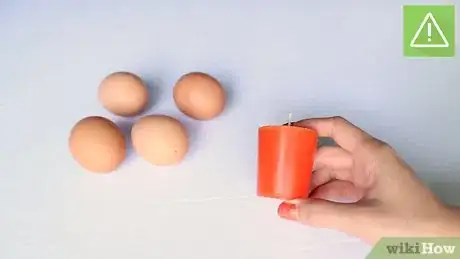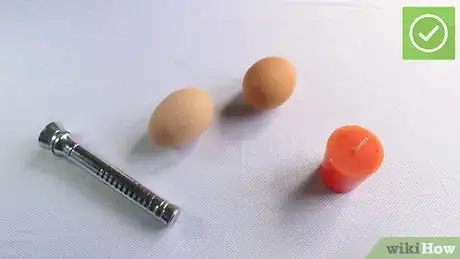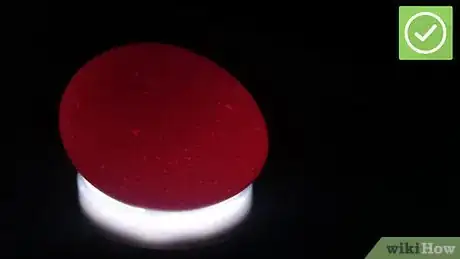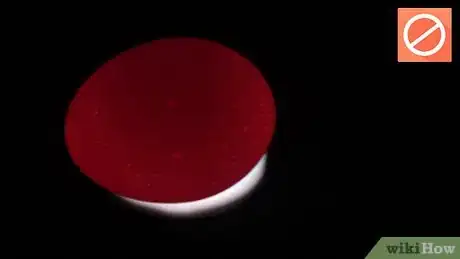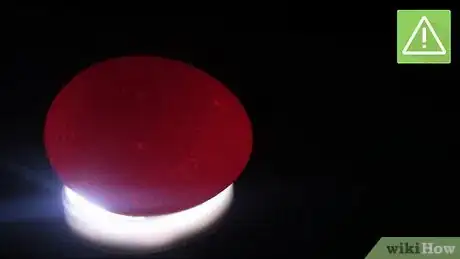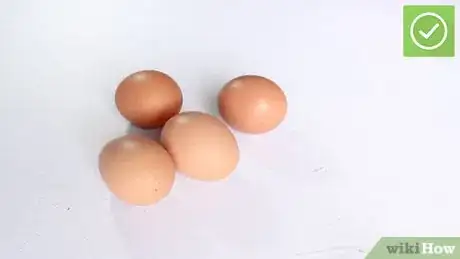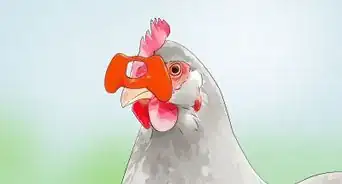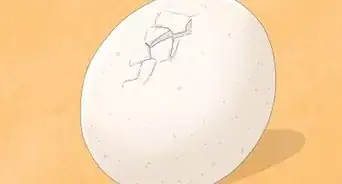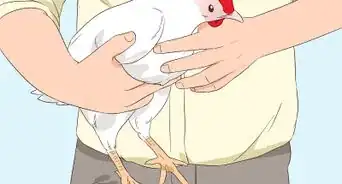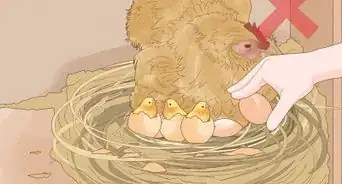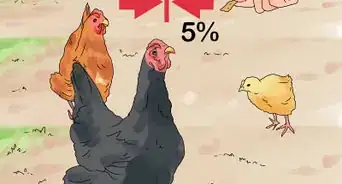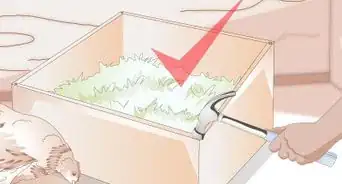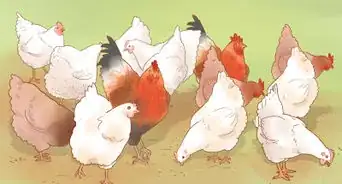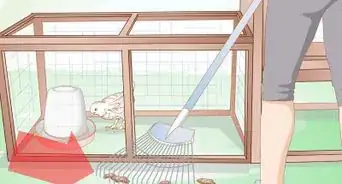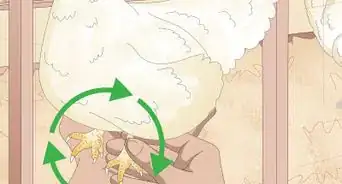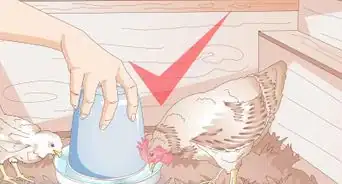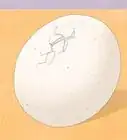wikiHow is a “wiki,” similar to Wikipedia, which means that many of our articles are co-written by multiple authors. To create this article, 23 people, some anonymous, worked to edit and improve it over time.
There are 10 references cited in this article, which can be found at the bottom of the page.
wikiHow marks an article as reader-approved once it receives enough positive feedback. This article received 13 testimonials and 92% of readers who voted found it helpful, earning it our reader-approved status.
This article has been viewed 418,118 times.
Learn more...
Chicken farmers use candling to learn which of their chicken's eggs are fertile and will hatch into baby chicks. Candling can also be used to tell if a fertilized egg has stopped developing. The candling process works by illuminating the interior of an egg so you are able to see what is inside the shell. This article will show you the correct procedure for candling an egg.
Steps
Understanding the Candling Process
-
1Understand why you need to candle your eggs. When you are hatching eggs at home, it is good practice to keep track of how the eggs are developing. However, this can be very difficult (if not impossible) without the use of candling. Candling involves shining a bright light into the egg, allowing you to see its contents and check whether it is developing properly.[1]
- When you are hatching eggs at home, you will never get a 100% hatch rate. Some eggs will not be fertile to begin with (these are called "yolkers") while others will stop developing at some point during the incubation process (these are known as "quitters").
- It is important that you are able to identify and remove these yolkers and quitters during the incubation process, otherwise they can begin to rot and eventually burst inside the incubator, contaminating the other eggs with bacteria and creating a very bad smell.
-
2Use the correct candling equipment. Candling equipment doesn't need to be very fancy or specific - in fact, in the old days it used to be done with the flame from a candle (hence the name). The main requirement is a bright light (the brighter the better) with an opening smaller than the diameter of the eggs you intend to candle. You will need to conduct the candling in a very dark room in order to see inside the egg.[2]
- You can buy specific egg candling devices at any poultry supply store. These usually look like small flashlights which are powered either by batteries or a plug-in cord.
- You can make your own egg candler at home by placing a 60 watt light bulb inside a coffee can and making a hole with a 1 inch (2.5 cm) diameter in the top of the can. Alternatively, you can take a very bright flashlight and cover the opening with a piece of cardboard with a hole (1 inch in diameter) in the middle.[3]
- A more high-tech, expensive option for candling eggs is known as an Ovascope. This has a rotating stand on which you place the egg. The egg is then covered by a hood which blocks out any ambient light. You can then view the egg through an eyepiece, which magnifies the egg slightly for easier inspection.[4]
Advertisement -
3Follow an appropriate candling schedule. You should candle your eggs before you even put them in the incubator. You probably won't be able to see anything, let alone differentiate between good and bad eggs, but it will give you an indication of what an undeveloped egg looks like, which can be useful for comparison later.[5]
- It may also be helpful to look out for any tiny cracks which are not visible to the naked eye. Cracked eggs are more susceptible to harmful bacteria getting inside and affecting the development of the embryo. If you find an egg with a crack, do not discard it just yet, but make sure to take note of the crack and check the egg's progress later.
- Although some people will candle their eggs every day while they are incubating, it is a good idea to wait until about day seven. There are two reasons for this.
- Number one: Eggs are temperature sensitive and constantly moving them in and out of the incubator could negatively affect their development, especially at this early stage.
- Number two: Before day seven the eggs will not have developed very much and it will be difficult to distinguish between good and bad eggs.
- After the candling on day seven you should leave the eggs alone til about day fourteen. At this point, you will be able to double check any eggs that you were uncertain about the first time and discard them if there are still no signs of development.[6]
- You should refrain from candling after day sixteen or seventeen, as the eggs should not be moved or even turned in the days leading up to the hatching. In addition, the embryos will have developed so much by this stage that they will fill the inside of the egg, so you will be able to see very little.[7]
Candling the Eggs
-
1Hold the egg above the light. Set up your candling equipment in a dark room within close proximity to the incubator. Select an egg from the incubator and hold it above the light. The correct way to do this is as follows:[8]
- Place the larger end of the egg (where the air sac is) directly against the light. Hold the egg near the top, between your thumb and forefinger. Tilt the egg slightly to one side and rotate until you get the best view.
- As you work, you should mark each egg with a number and take notes on your findings. That way, you can compare the results of your first candling with the results of your second candling.
- Try to work quickly, but not so fast that you risk dropping the egg. As long as the eggs are returned to the incubator within twenty minutes to half an hour, there is no risk of the candling process affecting their development. A mother hen will frequently leave her eggs for short periods of time while she is incubating them.
- Be aware that it will be more difficult to candle brown or speckled eggs as the dark shells do not become as transparent under the light.
-
2Look for signs that the egg is a winner. A winner is an egg with a successfully developing embryo. You can tell if an egg is a winner using the following signs:[9]
- There will be a visible network of blood vessels spreading from the center of the egg outwards.
- With a weaker candler, you might just be able to make out the clear bottom half of the egg (where the air sac is) and the darker top half of the egg (where the embryo is developing).
- With a good candler, you might be able to see the dark outline of the embryo at the center of the network of blood vessels. You are most likely to see the embryo's eyes, which are the darkest spots inside the egg.
- If you're lucky, you might see the embryo moving!
-
3Look for signs that the egg is a quitter. A quitter is an embryo which has stopped developing at some point during incubation, for one reason or another. Some quit due to poorly maintained temperatures or humidity, some are contaminated by bacteria, while others simply have bad genes.
- The main indication that an egg is a quitter is the development of a blood ring. A blood ring looks like a well-defined red circle, which is visible on the inside of the shell. It forms when the embryo dies and the blood vessels supporting it pull away from the center and rest against the shell.
- Other indications that an egg is a quitter include the development of blood spots or blood streaks inside the egg. However, these dark patches can be difficulty to distinguish from a healthy embryo at this early stage.
- If you are 100% certain that the egg is a quitter (the appearance of a blood ring is a very definite sign) then you should discard the egg immediately to prevent it from turning bad and exploding inside the incubator.
-
4Look for signs that the egg is a yolker. A yolker is an egg that was never fertilized and has no chance of developing an embryo. You can tell if an egg is a yolker using the following signs:
- The egg looks the exact same as it did when you first candled the eggs before putting them in the incubator.
- The inside of the egg looks fairly clear, with no visible dark spots, blood vessels or blood rings.[10]
-
5If you are unsure, leave the eggs alone. If you think you might have identified a yolker or a quitter, but are not 100% sure, do not discard them just yet. If you do, you run the risk of throwing away healthy eggs.
- Just make a note of which eggs have a question mark over them, then place them back in the incubator. It is always worth giving them another chance.
- Check the questionable eggs again on day fourteen. If there are still no obvious signs of development or if a blood ring has finally formed, you can discard them.
Community Q&A
-
QuestionCan I use a regular flashlight?
 Community AnswerYes, or you can get the flashlight app for your phone.
Community AnswerYes, or you can get the flashlight app for your phone. -
QuestionWhen I was candling the egg, it looked like it was cracked, but it was not on the outside. Is it a bad egg?
 Heidi Joe CollinsCommunity AnswerIt may not be a bad egg, but could be a hairline crack that cannot be felt. It's best to look for defects in the eggs before the start of incubation to help avoid problems and ensure the healthiest chicks.
Heidi Joe CollinsCommunity AnswerIt may not be a bad egg, but could be a hairline crack that cannot be felt. It's best to look for defects in the eggs before the start of incubation to help avoid problems and ensure the healthiest chicks. -
QuestionHow many times should I turn the egg and when do I stop rotating it?
 Community AnswerTurn the eggs three times a day. Stop turning them on day 18 and raise the humidity level to around 70%.
Community AnswerTurn the eggs three times a day. Stop turning them on day 18 and raise the humidity level to around 70%.
Warnings
- Do not attempt to eat any yolker eggs that have been sitting inside the incubator. They are no longer fresh and could make you very ill.⧼thumbs_response⧽
Things You'll Need
- Bright flashlight
References
- ↑ https://www.raising-happy-chickens.com/candling-eggs.html
- ↑ https://lancaster.unl.edu/4h/embryology/candling.shtml
- ↑ http://urbanext.illinois.edu/eggs/res25-candler.html
- ↑ http://www.motherearthnews.com/homesteading-and-livestock/how-to-candle-eggs-zebz1305zstp.aspx?PageId=1#ArticleContent
- ↑ https://poultrykeeper.com/incubating-and-hatching-eggs/candling-eggs/
- ↑ http://voices.yahoo.com/when-candle-chicken-eggs-5933516.html?cat=7
- ↑ http://www.backyardchickens.com/a/how-to-make-a-homemade-egg-candler-using-common-household-materials
- ↑ https://www.thespruce.com/definition-of-candling-3016955
- ↑ https://keeping-chickens.me.uk/chickens/how-to-hatch-eggs/candling-eggs/
About This Article
To candle an egg, start by setting up your candling equipment in a dark room close to the incubator. Next, place the larger end of the egg against the light, and tilt it until you get the best view. Mark the eggs as you go, making notes on what you see so you can keep track of the egg’s development. Then, return the egg to the incubator, ideally within 20-30 minutes to keep the egg from getting too cold. Additionally, only candle an egg on days 7 and 14 since you want to keep them safe in the incubator as much as possible. To learn how to differentiate between a winner and a quitter egg, keep reading!
